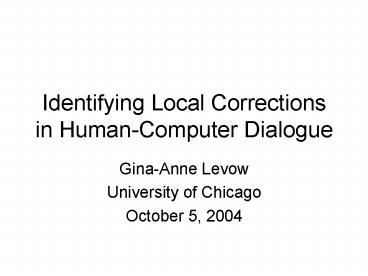Identifying Local Corrections in Human-Computer Dialogue - PowerPoint PPT Presentation
1 / 13
Title:
Identifying Local Corrections in Human-Computer Dialogue
Description:
SER still high for conversational speech. Error resolution is crucial ... Corpus: 2000, 2001 Communicator Eval'n. Telephone-only interface to travel information ... – PowerPoint PPT presentation
Number of Views:20
Avg rating:3.0/5.0
Title: Identifying Local Corrections in Human-Computer Dialogue
1
Identifying Local Correctionsin Human-Computer
Dialogue
- Gina-Anne Levow
- University of Chicago
- October 5, 2004
2
Roadmap
- Problem
- Data collection analysis
- Identifying local corrections
- Conclusions future work
3
The Problem
- U October eleventh
- S Okay, leaving October fifth
- U October eleventh
- Goal Pinpoint WHAT is being corrected
- Builds on recognition of corrections
- (Kirchoff, 2001 SHL, 2000 Levow 1998)
4
Why Identify Local Corrections?
- Miscommunication is inevitable
- SER still high for conversational speech
- Error resolution is crucial
- Easy recovery more important than WER
- (Walker et al, 2001 Shriberg et al, 1992)
- Facilitates recovery
- Adaptive dialogue strategy
5
Challenge Response
- Few lexical/syntactic cues
- Cue phrases rare, e.g. No I meant
- May be identical to legal original input
- Near repetitions common
- E.g. departure and return dates
- Approach Exploit prosodic cues
- Wizard-of-Oz study found significant contrasts
- Increases in duration, pitch, intensity (Oviatt
et al 1998)
6
Data Collection
- Corpus 2000, 2001 Communicator Evaln
- Telephone-only interface to travel information
- Air, hotel, car
- gt160 hours of interactions,43K utts
- Local corrections
- Single focus of correction
- Error identifiable from system response
7
Local Correction Set
- Lexically matched
- U October eleventh
- S Okay, leaving October fifth
- U October eleventh
- Lexically unmatched
- U October eleventh
- S Okay, leaving October fifth
- U The eleventh of October
- 57 utterances 200 total words, 57 corrective
- Automatically identified from logs, manually
checked
8
Prosodic Features Analysis
- Pitch, Intensity
- Maximum, Minimum, Mean, Range
- From Praat (Boersma 2001), smoothed
- Utterance normalized, per-word
- Duration
- Normalized (ATIS-based phoneme durs, Chung
Seneff 1997) - Significant increases in duration
- Local correction words ONLY
- No other measures reach significance (cf. Oviatt)
9
Local Correction
10
Local Correction II
11
Local Correction Classification
- Classifier Boostexter (Schapire Singer, 2000)
- Feature selection, avoid overfitting
- 5-way cross-validation
- Report average over runs
- Features
- Duration
- Pitch, Intensity (Max, Min, Mean, Range)
- Normalized values
- Within utterance ranks
12
Localizing Corrections
- Baseline Most common class 71.5
- Overall 85.5
- Lexically matched 81.25 (Baseline 59)
- Unmatched 87 (Baseline80)
- Rank-based features crucial
- Using normalized values degrades performance
- Key features
- Pitch range Approaches best
- Maximum pitch, Maximum intensity
- Duration less useful
13
Conclusion Future Work
- Prosodic cues identify focus of correction
- Pitch range Pitch, Intensity Maximum
- Rank-based features key
- Correspond to utterance level prominence
- Increased pitch max, range, intensity,duration
- Extend beyond single correction point
- Phrasal units, Multi-point
- Integrate recognition with dialogue management

